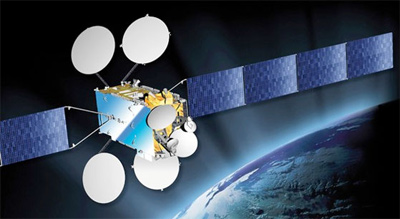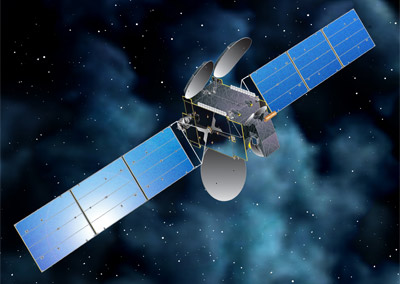



As we all know with Europe's flagship rocket, in recent years most of its launches are share rides, which lead to some interesting pairing of customers on one Ariane 5 flight.
This time though, you really can't find a more famous tag team than the one launching tomorrow!
Two of the world's largest comsat operators are meeting together with satellites from both companies flying on the same Ariane 5 - I believe a first for the two famous satellite communication operators! Eutelsat's Eutelsat 8 West B and Intelsat's Intelsat 34 are both aiming to provide HDTV and other communication services to either sides of the Atlantic Ocean, from Europe, Middle East, Africa to North and South Americas. Eutelsat 8 West B was ordered to meet TV broadcasting demands in the region, while Intelsat 34 is a replacement of Intelsat 27 that got dumped into the Pacific Ocean 2.5 years ago.
Watch out for even more activities at Kourou with at least 5 more flights from there till the end of the year!
Launch location:
Kourou Launch pad ELA-3 5° 14'06.34"N, 52° 46'06.34"W
Launch dates and times:
Time Zone |
Paris /CEDT
|
Universal / UTC
|
Kourou / UTC-3
|
Washington / EDT
|
Los Angeles / PDT
Launch time (Primary):
|
22:10:00
|
20:10:00
|
17:10:00
|
16:10:00
|
13:10:00
on:
|
Aug. 20, 2015
|
Aug. 20, 2015
|
Aug. 20, 2015
|
Aug. 20, 2015
|
Aug. 20, 2015
{colsp=6}
[highlight][eventTimer]2015-08-20 20:10:00?before|after;%dd% Days %hh% Hours %mm% Minutes %ss% Seconds %c%[/eventTimer] Ariane flight VA-225 Launch[/highlight]
Live Coverage Of The Launch:
- Arianespace: http://www.arianespace.tv/ (begins at 20 minutes before lift-off)


PAYLOAD 1
Eutelsat 8 West B communication satellite:

Mission Summary
Eutelsat Communications announced the order of a of a new Spacebus 4000 C3 satellite from Thales Alenia Space in October 2012. Called Eutelsat 8 West B, the high-capacity spacecraft will be launched in 2015 to 8° West, joining satellites already operated at the adjacent 7° West position by Eutelsat and the Egyptian satellite company, Nilesat. Broadcasting services from both positions are received by satellite TV homes with a single small Direct-to-Home dish.
With a rapidly growing audience and channel line-up, the 7/8° West video neighbourhood is one of the most dynamic in the global satellite TV market. Over 30 million homes in North Africa and the Middle East are already equipped for DTH reception of more than 800 Arabic and international channels broadcast at this position by Eutelsat and Nilesat. Free-to-air accounts for the majority of the offer (500 channels), while HD take-up is accelerating, currently representing 50 channels. The additional capacity will meet further expansion in a satellite broadcasting market where capacity demand for video services is forecast to grow by 6.8% a year over the coming five years (source Euroconsult). HDTV channels are expected to increase fourfold over the coming ten years.
The Eutelsat 8 West B satellite will be equipped with 40 operational Ku-band transponders designed primarily to serve DTH markets in North Africa and the Middle East. It will also introduce a C-band mission to 8° West, with 10 operational transponders connected to footprints covering the African continent and reaching west to South America.
To respond to the popularity of the 7/8° West neighbourhood, Eutelsat will redeploy an existing high-power Ku-band satellite to 8° West in 2013. This will increase resources in advance of the launch of Eutelsat 8 West B, enabling more broadcasters to benefit from a prime neighbourhood.
Parameter | Value
Working Orbit:
|
GEO
Orbital Location:
|
8° West
Coverage:
|
North Africa and Middle East (Ku-band), Africa and Eastern South America (C-band)
ApA at separation:
|
35845 km
PeA at separation:
|
252 km
Inc at separation:
|
4.7°Eutelsat 8 West B
Customer:
|- Eutelsat
Prime contractor:
|- Thales Alenia Space
Platform:
|- Spacebus 4000C4
Mass at Separation:
|- 5782 kg
Dry Mass:
|- ?
Stabilization:
|- 3 axis stabilized
Dimensions (stowed):
|- 5.5 x 2.0 x 2.2 m
Dimensions (deployed span):
|- ?
On-board power:
|- 15 kW at end of life
Communication Payload:
|- 40 Ku-band transponders
- 10 C-band transponders
Life time:
|- 15 years
Ku-band Transponders coverage:
|C-band Transponders coverage:
||


PAYLOAD 2
Intelsat 34 communication satellite:

Mission Summary
Space Systems/Loral announced in July 2013 that it has been awarded a contract to provide a new satellite to Intelsat. Intelsat 34 will serve the role originally intended for the lost Intelsat 27. This includes providing capacity to meet the growing needs of Latin American media customers, as well as broadband for aeronautical companies serving the busy North Atlantic routes.
Intelsat 34, unlike its predecessor, does not include the UHF-band that Intelsat had been unable to sell to its intended customer, the U.S. Department of Defense.
Scheduled for launch in 2015, Intelsat 34 will replace Intelsat 805 and Galaxy 11 at 304.5° East longitude. Intelsat 34 is designed to deliver service for 15 years or longer.
Parameter | Value
Working Orbit:
|
GEO
Orbital Location:
|
55.5° West
Coverage:
|
Americas, Western Europe, Africa, Brazil, North Atlantic Region
ApA at separation:
|
35845 km
PeA at separation:
|
252 km
Inc at separation:
|
4.7°Intelsat 34
Customer:
|- Intelsat
Prime contractor:
|- Space Systems/Loral
Platform:
|- LS-1300
Mass at Separation:
|- 3300 kg
Dry Mass:
|- ?
Stabilization:
|- 3 axis stabilized
Dimensions (stowed):
|- 5.6 x 3.5 x 3.0 m
Dimensions (deployed span):
|- ?
On-board power:
|- 10 kW at end of life
Communication Payload:
|- 24 Ku-band transponders
- 24 C-band transponders
Life time:
|- 15 years
Ku-band Transponders coverage:
|C-band Transponders coverage:
||


Launch Vehicle:

Ariane 5 ECA
Prime contractor:
|- Airbus Defence and Space (ex-EADS Astrium)
Height:
| 50.5 m with upper stage and payload fairingDiameter:
| max 11.56 mLiftoff mass:
| 780 metric tonnesPayload mass:
| ~10 tonnes at GTO (1500 m/s to GEO)SOLID ROCKET BOOSTER (EAP):
|- 2 X P241 motor
- Empty 38 tonnes
- Propellants 240 tonnes (HTPB)
- Thrust in vacuum 700 tonnes of force
- Thrust at sea level 509.9 tonnes of force
CRYOGENIC MAIN CORE STAGE (EPC):
|- 1 X Vulcain-2 engine
- Empty 14.7 tonnes
- Propellants 170 tonnes (LOX + LH2)
- Thrust in vacuum 139 tonnes of force
- Thrust at sea level 96 tonnes of force
CRYOGENIC UPPER STAGE (ESC-A):
|- 1 X HM7B engine
- Empty 4.54 tonnes
- Propellants 14.9 tonnes (LOX + LH2)
- Thrust in vacuum 6.7 tonnes of force
Payload Fairing:
|- Diameter 5.4 m
- Length 17 m
- Mass 2675 kg
The vehicle's reliability statistics according to http://www.spacelaunchreport.com/log2015.html#rate:
Code:
================================================================
Vehicle Successes/Tries Realzd Pred Consc. Last Dates
Rate Rate* Succes Fail
================================================================
Ariane 5-ECA 49 50 .98 .96 49 12/11/02 2002-
Ariane VA225 Ascent Profile
The launcher’s attitude and trajectory are totally controlled by the two onboard computers, located in the Ariane 5 vehicle equipment bay (VEB).
7.05 seconds after start of the ignition of the main stage cryogenic engine at T-0, the two solid-propellant boosters are ignited, enabling liftoff. The launcher first climbs vertically for 6 seconds, then rotates towards the East. It maintains an attitude that ensures the axis of the launcher remains parallel to its velocity vector, in order to minimize aerodynamic loads throughout the entire atmospheric phase, until the solid boosters are jettisoned.
The fairing protecting the Eutelsat 8 West B and Intelsat 34 spacecraft is jettisoned at T+220 seconds.
Once this first part of the flight is completed, the onboard computers optimize the trajectory in real time, minimizing propellant consumption to bring the launcher first to the intermediate orbit targeted at the end of the main stage propulsion phase, and then the final orbit at the end of the flight of the cryogenic upper stage.
The main stage falls back off the coast of Africa in the Atlantic Ocean (in the Gulf of Guinea). On orbital injection, the launcher will have attained a velocity of approximately 9,365 meters/second, and will be at an altitude of about 643.2 kilometers.
Ariane VA225 Ascent Timeline
Start of synchronized sequence|-00:07:00|20:03:00|
Ignition of the cryogenic main stage engine (EPC)|00:00:00|20:10:00|
Liftoff (Ignition of solid boosters)|00:00:07.3|20:10:07.3|
End of vertical climb and beginning of pitch rotation (10 seconds duration)|00:00:12.6|20:10:12.6|
Beginning of roll manoeuvre|00:00:17.0|20:10:17.0|
Jettisoning of solid boosters|00:02:24|20:12:24|
Payload Fairing Separation|00:03:21|20:13:21|
Shut-down of main cryogenic stage|00:08:51|20:18:51|
Separation of main cryogenic stage|00:08:57|20:18:57|
Ignition of upper cryogenic stage (ESC-A)|00:09:06|20:19:06|
End of first ESC-A thrust phase / Injection|00:24:58|20:34:58|
Separation of Star One C4 satellite|00:28:19|20:38:19|
Separation of Sylda 5|00:30:40|20:40:40|
Separation of MSG-4 satellite|00:41:54|20:51:54|



Weather forecast for Kourou, French Guiana on August 20, 2015 (5 p.m.)
Partly cloudy in the morning. Thunderstorms developing later in the day. High around 30C. Winds light and variable. Chance of rain 80%.
5 PM|28°C|26°C|88%|47%|0%|58%|1010 hPa|8 km/h E|
References
http://www.arianespace.com
http://www.arianespace.tv
http://www.eutelsat.com/en/satellites/EUTELSAT-8WB.html
http://www.intelsat.com/infrastructure/satellites-and-coverage-maps/upcoming-launches/intelsat-34/
http://www.arianespace.com/images/launch-kits/launch-kit-pdf-eng/VA225-launchkit-GB.pdf
http://english.wunderground.com/q/zmw:00000.1.81403?
http://forum.nasaspaceflight.com
http://www.spacelaunchreport.com
http://space.skyrocket.de
































